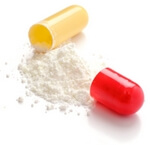Sodium Selenite in Dog Food — Vital Nutrient or Dangerous Toxin?
Sodium selenite can be controversial substance when it’s used in a dog food recipe.

That’s because although the mineral is essential for normal cell function in all animals, selenium can be toxic in high doses.
What’s worse, the mineral’s toxicity also seems to be related to the chemical form used to make a each recipe.
Natural Selenium — or Sodium Selenite?
For example, one study using rats (not dogs) suggested sodium selenite was 2.94 times more toxic than natural selenium yeast.1
This more natural and organic form of selenium produced by yeast is known as selenomethionine. And based upon human studies, this compound is not only less toxic, it also more closely mimics the form of the mineral found in fresh food.2
So, it’s more biologically available to the animal.
Why Any Mineral Can Be Toxic
To be fair, it’s important to note that any mineral (copper, calcium, phosphorus, zinc, etc.) or vitamin can become toxic when fed in excessive amounts.
This dangerous “over-nutrition” condition is known as toxicosis.
The 2010 Blue Buffalo dog food recall is a perfect example of how even too much of a vitamin (in this case, vitamin D) can be toxic.
How Much Selenium Is Too Much?
According to AAFCO, the maximum amount of selenium used in a dog food should not exceed 2.0 mg/kg on a dry matter basis — or about 18 times the recommended minimum of 0.11 mg/kg.
And on a caloric basis, the maximum suggested selenium content is 0.57 mg per 1000 calories of food — which is about 19 times the minimum 0.03 mg for the mineral.
Although AAFCO sets a maximum for most minerals, the National Research Council3 has yet to determine the safe upper limit for many inorganic nutrients — including selenium.
Why It’s Controversial
The controversy appears to be over the use of sodium selenite to supply trace amounts of selenium to a dog food.
Those opposed to sodium selenite — or its close chemical cousin, sodium selenate — are concerned about what they believe to be a notably thin margin of safety between an effective “dose” of the mineral and the amount that could cause toxicity.
So, a supplement supplier that provides slightly too much selenium to a commercial nutrient mix could make it easy for a dog owner to unknowingly administer a toxic dose to her pet over an extended period of time.
Although this concern could certainly be justified, history doesn’t appear to support this view.
The Bottom Line
Unfortunately, it looks like the sodium selenite controversy might be creating unnecessary concern for dog owners. And favoring selenium yeast as a source of selenium might be a better idea.
“Indeed, selenium has an excellent safety record, and the only cases of selenium toxicity, which occurred several decades ago, were due to inadvertent dosage errors by inexperienced supplement manufacturers which were not using selenium yeast or selenomethionine in their products.” 4
However, simply seeing the words “selenium yeast” on a dog food ingredients list is no guarantee of quality. After all, some of these items may have been made with yeasts containing sodium selenite instead of the preferred organic compound — selenomethionine.
What’s more, the overwhelming majority of dog foods — even some of the very best — contain the sodium selenite version of selenium.
Since only a handful of foods are made with biologically superior selenium yeast, avoiding sodium selenite may be impractical.
What Can You Do?
Unfortunately, not much. That’s because when it comes to vitamin or mineral toxicity of any kind, it’s a matter of trust.
It’s more a matter of trusting a manufacturer to seek out quality supplements — and add them accurately — with care — to each batch.
Although no one can assure you any dog food will be 100% safe from containing excessive amounts of any mineral, you can take at least some comfort in the reasonable margin of safety between the AAFCO minimums and maximums for selenium.
In any case, those who still consider themselves “selenite-phobic” should simply look for foods that contain selenium yeast rather than sodium selenite.
And be sure to check out my review of your favorite brand. Look in the yellow dashboard area for the included ingredients. Sodium selenite — if present — is typically located near the end of the list.



